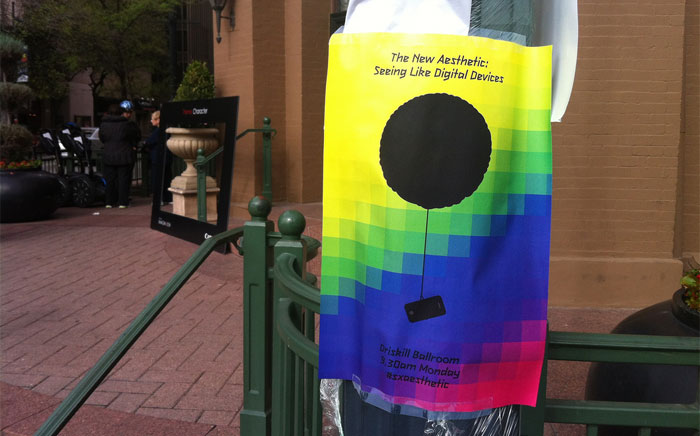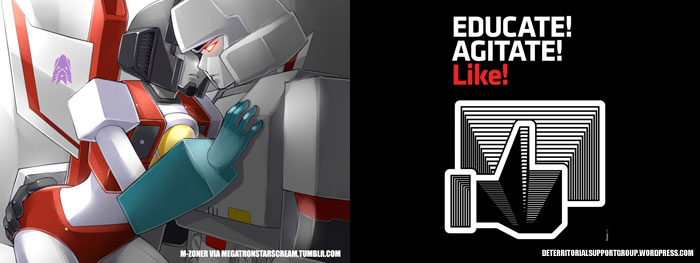Report from Austin, Texas, on the New Aesthetic panel at SXSW.

At SXSW this year, I asked four people to comment on the New Aesthetic, which if you don’t know is an investigation / project / tumblr looking at technologically-enabled novelty in the world.
(Previously: the original blog post, the main tumblr, my talk at Web Directions South.)
I opened the panel by talking about the origins of NA, in a frustration at retro-ness (the belief that authenticity can only be located in the past)—best encapsulated by Russell’s post here:
Every hep shop seems to be full of tweeds and leather and carefully authentic bits of restrained artisinal fashion. I think most of Shoreditch would be wondering around in a leather apron if it could. With pipe and beard and rickets. Every new coffee shop and organic foodery seems to be the same. Wood, brushed metal, bits of knackered toys on shelves. And blackboards. Everywhere there’s blackboards.
—as well as a real sense that there were new and extraordinary things and experiences in the world, like the ability to see through satellites, which we should wonder at and explore, but instead reduce to the mundane, like GPS driving directions…
One of the core themes of the New Aesthetic has been our collaboration with technology, whether that’s bots, digital cameras or satellites (and whether that collaboration is conscious or unconscious), and a useful visual shorthand for that collaboration has been glitchy and pixelated imagery, a way of seeing that seems to reveal a blurring between “the real” and “the digital”, the physical and the virtual, the human and the machine. It should also be clear that this ‘look’ is a metaphor for understanding and communicating the experience of a world in which the New Aesthetic is increasingly pervasive.

What has been brilliant about the New Aesthetic for me, personally, is that it has produced work, it has made me see and think about the world in a strange way, out of which thinking strange things have fallen, like Rorschmap and Robot Flaneur and Balloon Drones and Shadows, of which more anon.
But what has also been brilliant is that other people have pitched in. I first realised that NA was “a thing” not in that first blog post (I would have given it a better name) but when people started responding and writing about it. They started coming to me, bringing things, and saying “is this New Aesthetic?” or even “I think this is New Aesthetic” and I’d go yes, possibly, or better, why do you think that?
Names have power (I showed a slide of Aleister Crowley at this point; hell, I’ll show it again—).

—giving something a name gives you power over it, but it also gives other people power too. Other people can pick up your tool and use it. (Sidenote, which we’ll return to: I’ve always loved this aspect of language. It’s at the core of the invisible book club, and the best example of it I’ve experienced lately is China Miéville’s “The City & The City” which yes I am still banging on about because it gives you new words—breeching, cross-hatching—for things you know but can’t describe and which you can use as keys to open the world in all its Sapir-Whorfian glory).
Anyway, the point about the brilliance of NA as a shareable concept is that other people respond, and I wanted to show that at SXSW by inviting four people—friends old and new—to respond as they saw fit, which might be any way at all. And they did, and you should read what they had to say (follow the links to their sites):
- Joanne McNeil, editor of Rhizome, spoke about the history of new aesthetics, on new perspectives, technologies and art.
- Ben Terrett, designer, on the New Aesthetic in commercial visual culture.
- Aaron Straup Cope, artist and developer, on drones, data and human geography.
- Russell Davies, reckoner of this parish, on the New Aesthetic and writing.
They are all smart and good and you should go and read them now. (You are missing the title cards and the jingles, but I guess you had to be there for that. Also the drone. Later, we took it swimming.)
I came back on at the end to tell a few stories from the New Aesthetic. It was somewhat incoherent, in the way that talks are allowed to be but essays less so, but I shall try to lay it out.
I went to CERN, and one of the many great things about it is that people are doing things there in order to understand what they are doing, and it’s this vast iterative process with no definite outcome, but we do it because, perhaps, this is what we do when we encounter new things; we cannot do otherwise. We must stare at them ever longer and harder to understand what they mean.

Like this building and this photograph. The first is Telehouse’s new datacenter in East London which I have spoken about many times : why is it pixelated? Is it an attempt to render the network, the digital, visible? What form does the architecture of the network take, and what is the significance of the network’s irruption into physical space? (See also.)
What is the extraordinary interweaving of events that must occur for this image to exist? (It is the Free Bradley Manning section of San Francisco Pride). How many networks have been traversed by ideas and images and people for this thing to happen and be seen? And what Julian Assange said [PDF]: “We must think beyond those who have gone before us, and discover technological changes that embolden us with ways to act in which our forebears could not.” If we have not found what we are looking for yet, what we are looking for must be found in the new.

And what of the render ghosts, those friends who live in our unbuilt spaces, the first harbingers of our collective future? How do we understand and befriend them, so that we may shape the future not as passive actors but as collaborators? (I don’t have much truck with the “don’t complain, build” / “make stuff or shut up” school, but I do believe in informed consent.)
Because a line has been crossed, technology/software/code is in and of the world and there’s no getting out of it. Some architects can look at a building and tell you which version of autodesk was used to create it. The world is defined by our visualisations of it. (Someone who makes such things told me: what they put in, even as place-holders, always ends up getting built. Lorem Ipsum architecture.)

People are writing stories about having sex with robots on the internet—turning all of literature and technology into creativity and amusement while simultaneously undermining all previous notions of authorial authority and intellectual property. (I was talking about slashfic and possibly starpunk too.)
People are “acting” in ways we may or may not understand, which may or may not have an effect in the real world, whether it’s signing petitions, organising riots (on BBM), clicking, ‘liking’ KONY, whatever, the correct (maybe) response is not to have an opinion (default internet response, still) or a moral position, but to live inside the thing as it unfolds.
I think at this point I might have quoted Kafka and then gone on a rant about how brilliant Tumblr is:
You do not need to leave your room. Remain sitting at your table and listen. Do not even listen, simply wait, be quiet still and solitary. The world will freely offer itself to you to be unmasked, it has no choice, it will roll in ecstasy at your feet.

I said that we need to invent new words for everything, preferably/not really Long German ones, because we are experiencing genuinely new things, and we should not shy away from that fact. Yes, everything has always been new and different and everything has always been the same, but we can perform an end-run around this endless back-and-forth between contemporary boosterism and conservative ever-wasness by getting excited about the fact that new ways of seeing (/thinking) produce if not a new world then new sensations which are the medium by which we appreciate a new world (and for that tug at your heart, that drop in your stomach, when you see a distant place through the internet and a number of devices (including your friends drinking in a distant city in real-time on Twitter) and wish you were there I coin the term Strasseblickfernweh, or Street View wanderlust.)
I wrote this rant a while back on Flickr, about, essentially, the uneven distribution of exciting futures (there was something in the air last summer / there is always something in the air if you’re facing the right way)…

And Tom said:
It’s 2011, and I have no idea what anything is or does anymore.
At CERN, there was a video where a particle physicist was asked “What if you don’t find the Higgs Boson? What if you’re wrong about this?” and he thought that would be brilliant, because then they’d know a whole area they could block out and go OK, not this, but how about this?
Also, what Rilke said:
Perhaps all the dragons in our lives are princesses who are only waiting to see us act, just once, with beauty and courage. Perhaps everything that frightens us is, in its deepest essence, something helpless that wants our love.
Which must be true because Rilke said it (what would you bring down from the mountain?).
My point is, all our metaphors are broken. The network is not a space (notional, cyber or otherwise) and it’s not time (while it is embedded in it at an odd angle) it is some other kind of dimension entirely.
BUT meaning is emergent in the network, it is the apophatic silence at the heart of everything, that-which-can-be-pointed-to. And that is what the New Aesthetic, in part, is an attempt to do, maybe, possibly, contingently, to point at these things and go but what does it mean?

There’s a round-up of tweets from the session here (thanks to Paul), as well as a bunch from Bruce Sterling’s SXSW closing keynote (thanks to Chris), when he declared the NA to be at least one kind of future. He also wrote it up for Wired.
Thanks very much to Joanne, Ben, Aaron and Russell for agreeing to and indeed taking part in this ongoing discussion (do read their blog posts), also to Chris and George for moral support, and to everyone who came. All will continue, no doubt, here and at the NA.
[…] most interested me (as with many people) was the New Aesthetic, hosted by James Bridle. You can read his write-up, and then thoughts on their own blogs from Joanne McNeil, Ben Terrett, Aaron Straup Cope, […]
Pingback by Postmodernism, Authenticity, the Internet and the New Aesthetic — March 16, 2012 @ 5:06 pm